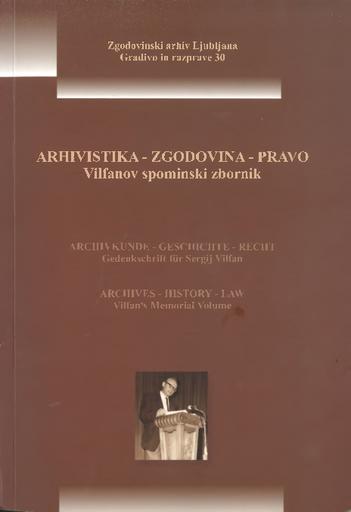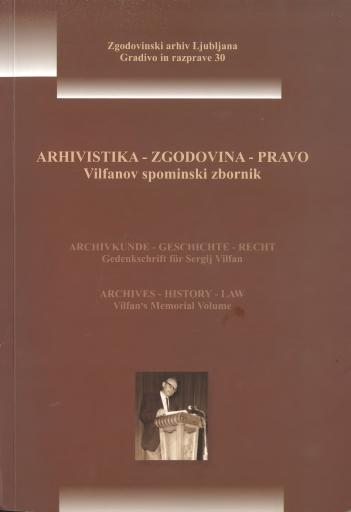/
Literatura
/
Monografije
Europäische Städteatlanten

Avtor(ji):Ferdinand Opll
Soavtor(ji):Nataša Budna Kodrič (ur.), Tatjana Šenk (ur.), Magda Lojk (lekt.), Doris Debenjak (prev.), mag. Niko Hudelja (prev.), Katarina Kambič (prev.), Martin Cregeen (prev.), Tatjana Rodošek (foto.)
Leto:2007
Založnik(i):Zgodovinski arhiv Ljubljana, Ljubljana
Jezik(i):nemščina, angleščina
Vrst(e) gradiva:besedilo
Zbirk(e):Gradivo in razprave : 30
Avtorske pravice:

To delo avtorja Ferdinand Opll je ponujeno pod Creative Commons Priznanje avtorstva-Nekomercialno-Brez predelav 4.0 Mednarodna
Datoteke (1)

Ime:arhivistika_zgodovina_pravo1.pdf
Velikost:26.99MB
Format:application/pdf
Stalna povezava:https://hdl.handle.net/11686/file25390
Opis
Starting with some basic deliberations about the importance of towns and urban life's sphere the paper is focused on the ample representation of towns (town-views and town-plans). A sketch of the organisational and institutional frame-work for the development of the respective research, i.e. urban historical science, for the last Century is being given. With respect to this the »International Commission for the History of Towns« founded at the International Historical Congress in Rome, 1955, which was under the presidency of Sergij Vilfan during the 1980's, is taking centre stage. The Commission with its big research-projects, especially the Towns Atlases meanwhile being published in 17 European countries, has contributed essentially in forming a decisive basis for respective research-activities. This is not only true with regard to the actual »spatial turn« of cultural Sciences. The function of Towns Atlases is much wider, in some respect they can be characterised as proper editions for urban research-work, and even far beyond historical disciplines.
The advancement of this Atlas-project from the late 1960’s onwards, from the
mere idea to its manifold realisation, is being illustrated, and it is by no meatis
exaggerated to speak about a real history of success. At the moment Towns Atlases
for no less than 435 European towns are already published — on the whole a propej
and plan-based editorial fundament for comparative analyses and studies. The
possibilities to make use of the Adases are another focus of the presentation, in the
end culminating in some cautious forecasts to the future development.
Metapodatki (12)
- identifikatorhttps://hdl.handle.net/11686/41387
- naslov
- Europäische Städteatlanten
- Ein Beitrag zu vier Jahrzehnten Stadtgeschichtswissenschaft in Europa
- European Down Atlases
- A Contribution to FourDecades of Urban Historical Research in Europe
- ustvarjalec
- Ferdinand Opll
- soavtor
- Nataša Budna Kodrič (ur.)
- Tatjana Šenk (ur.)
- Magda Lojk (lekt.)
- Doris Debenjak (prev.)
- mag. Niko Hudelja (prev.)
- Katarina Kambič (prev.)
- Martin Cregeen (prev.)
- Tatjana Rodošek (foto.)
- opis
- Starting with some basic deliberations about the importance of towns and urban life's sphere the paper is focused on the ample representation of towns (town-views and town-plans). A sketch of the organisational and institutional frame-work for the development of the respective research, i.e. urban historical science, for the last Century is being given. With respect to this the »International Commission for the History of Towns« founded at the International Historical Congress in Rome, 1955, which was under the presidency of Sergij Vilfan during the 1980's, is taking centre stage. The Commission with its big research-projects, especially the Towns Atlases meanwhile being published in 17 European countries, has contributed essentially in forming a decisive basis for respective research-activities. This is not only true with regard to the actual »spatial turn« of cultural Sciences. The function of Towns Atlases is much wider, in some respect they can be characterised as proper editions for urban research-work, and even far beyond historical disciplines. The advancement of this Atlas-project from the late 1960’s onwards, from the mere idea to its manifold realisation, is being illustrated, and it is by no meatis exaggerated to speak about a real history of success. At the moment Towns Atlases for no less than 435 European towns are already published — on the whole a propej and plan-based editorial fundament for comparative analyses and studies. The possibilities to make use of the Adases are another focus of the presentation, in the end culminating in some cautious forecasts to the future development.
- založnik
- Zgodovinski arhiv Ljubljana
- zbirka
- Gradivo in razprave : 30
- datum
- 2007
- 01. 01. 2007
- tip
- besedilo
- jezik
- Nemščina
- Angleščina
- jeDelOd
- pravice
- licenca: ccByNcNd
